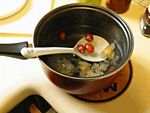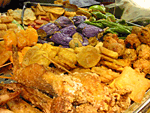What kinds of foods are important and what foods should be avoided according to different body constitutions?
TCM can apply some active measures to alter the physical constitution. According to its holistic concept, all aspects of a person's lifestyle including work, relationships, and daily habits are linked to health. The physical constitution of a person is determined by physiological functions, structures, and internal balances. Dietary guidelines (such as given below) can also help.
| Body type |
Dietary Advice |
Food examples |
| Yang and hot |
Foods with cool or cold energy, or having bitter flavors are appropriate.
Pungent, spicy and fried foods should be taken in moderation. Alcohol is pungent and hot in nature, so people with excessive yang should refrain from alcohol. |
Duck, jellyfish, crab, carrot, banana, watermelon, persimmon, pear, grapefruit, lily, mung bean, white fugus, bitter gourd, lettuce, bamboo shoot, Chinese kale, tomato, lotus root, laver, kelp, spinach and celery.
**Individuals are encouraged to eat more fruits and vegetables. |
| Yin and cold |
Foods with hot or warm energy, and having sweet and pungent flavors are appropriate.
Yin and cold foods should be taken in moderation. |
Chicken, goose, beef, mutton, milk products, eels, crucian carp, ribbonfish, cabbages, chives, leeks, dates, longan, litchi, peach, chestnut, plum, apricot, grapes, cane sugar, pumpkin, mushroom and ginger.
**Individuals are encouraged to eat foods with higher energy level. |
| Phlegm and damp |
Phlegm and damp foods that have a drying effect, benefit the spleen and stomach, and help to expel dampness and phlegm evils are suitable.
Don't overeat, avoid fat, alcohol and sweet foods should be taken in moderation. |
Celery, coriander, spinach, onion, loquat, ginkgo nut, Chinese dates, hyacinth bean, broad bean, lotus seed, job's tears, red bean, pear, radish, hawthorn, wax gourd, laver, jellyfish, clam (saltwater), papaya, sea grass, seaweed, asparagus, barley, Chinese cabbage, carrot, corn silk, cucumber, grape, hops, plum, onion, maltose and Chinese yam. |
| Dry |
Individuals' diet should be light. Foods that aid lubrication and promote body fluid production are suitable.
Hot, dried and greasy food should be avoided. |
Animal livers, pork, fish, bean curd, egg, lactose, honey, dairy products, pear, apple, sesame, spinach, sugar cane, yellow soybean, apple, apricot, coconut, dates, lemon, peach, plum, strawberry, tomato and white fungus, glutinous rice, Chinese sugar, lily and nuts. |
| Neutral |
A diet that blends different energies and flavors, and varied selection is appropriate. |
- |
The criteria for selecting food according to the body constitution is to balance the body's yin yang. For example, if a person with a hot body constitution (that means his "internal heat" predominates) eats cold foods, the cold energy of the food is absorbed into his body thus reducing the previously excessive internal heat. This helps balance the internal environment and the physical constitution will turn to neutral gradually.
The Chinese believe cooking food is an important process in aiding digestion. Firstly, it makes the food easy to absorb; and secondly, cooking alters the nature of food so that it caters to individual needs.
Some rules in cooking:
 |
|
 |
| Poaching method makes food more yin. |
|
Deep-fat frying makes food more yang. |
References
| English References: |
| 1. |
Chinese System of Food Cures Prevention & Remedies by Henry C. Lu.Sterling Publishing Co., Inc. 1986. |
| 2. |
The Tao of Food, Richard Craze and Ronifjay, 1999 Godsfield Press. |
| 3. |
Chinese Food: a Holistic Therapy by Tom Neuhaus, www.hopedance.org |
| 4. |
Medicinal Food in China by Junshi Chen, M.D. http://newcenturynutrition.com |
| 5. |
Cooling the Summer with Food: An Introduction to Medicinal Foods by Yanfang Wang, M.D., Ph.D. http://newcenturynutrition.com |
| |
|
| 中文參考﹕ |
| 1. |
党毅,中醫營養食療學,北京:科學出版社,1995 |
| 2. |
Dang Yi, Peng Yong, Li Wenkui, Chinese Functional Food, New World Press, 1999 |
| 3. |
Dang Yi, Wang Huizhu, Peng Yong, Chinese Health Tea, New World Press, 1999. |
| 4. |
羅元愷主編,中醫婦科學,上海:上海科學技術出版社,1986 |
| 5. |
史宇廣,單書健主編,小兒腹瀉專集,北京:中醫古籍出版社,1988 |
| 6. |
唐.孫思邈撰,備急千金要方,北京:人民衛生出版社影印,1955 |
| 7. |
元.忽思慧撰,劉玉書點校,飲膳正要,第一版,北京:人民衛生出版社,1986 |
| 8. |
高學敏,中藥學,第一版,北京:中國醫藥科技出版社,1990 |
| 9. |
冷方南等主編,中華臨床藥膳食療學,第一版,北京人民衛生出版社,1993 |
| 10. |
党毅,吃五穀更健康,第一版,臺灣:元氣齋出版社,1994 |
| |
|
| Written By: |
| Dang Yi (黨毅) MD PhD |
| Professor, Beijing University of Chinese Medicine; Visiting Professor, Middlesex |
| University, London, UK; Vice Director, Gourmet Food Institute of Health Care and Nutrition of Beijing, PRC. |
| |
| Editors: |
| Raka Dewan, Integrated Chinese Medicine Holdings Ltd. |
| Rose Tse, Integrated Chinese Medicine Holdings Ltd. |
|